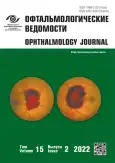The creation of a corneal incision with a femtosecond laser
- Authors: Nizametdinova Y.S.1, Takhtaev Y.V.2
-
Affiliations:
- Saint Petersburg State Hospital No. 2
- I.P. Pavlov First St. Petersburg State Medical University
- Issue: Vol 15, No 2 (2022)
- Pages: 75-81
- Section: Experimental trials
- URL: https://journals.rcsi.science/ov/article/view/109082
- DOI: https://doi.org/10.17816/OV109082
- ID: 109082
Cite item
Abstract
BACKGROUND: The cutting action of a femtosecond laser (FS-laser) on the corneal tissue is performed using a photodestructive effect. FS-laser technology is used in many different areas of corneal surgery, and studying this effect is an actual issue.
AIM: To evaluate the surface of the corneal incision created by a FS-laser (experimental study).
MATERIALS AND METHODS: 20 porcine eyes were divided into two groups (FS-laser and keratome). The corneal tissue surface in the area of contact between two lips of the incision was visualized by electron microscopy.
RESULTS: In all cases, we received a full-thickness incisions through the cornea. Images obtained by electron microscopy showed regular surface, no signs of thermal or mechanical damage to the corneal structure.
CONCLUSIONS: The FS-laser is used as a microscopic scalpel in surgery. The precision cutting process is performed by mechanical forces generated by photodestruction by expanding cavitation bubbles.
Keywords
Full Text
##article.viewOnOriginalSite##About the authors
Yulduz Sh. Nizametdinova
Saint Petersburg State Hospital No. 2
Author for correspondence.
Email: yulduzik55@gmail.com
ORCID iD: 0000-0002-6789-5780
SPIN-code: 7482-5163
Ophthalmologist
Russian Federation, Saint PetersburgYuri V. Takhtaev
I.P. Pavlov First St. Petersburg State Medical University
Email: ytakhtaev@hotmail.com
Dr. Sci. (Med.), Professor, Professor Yu.S. Astakhov Ophthalmology Department with Clinic
Russian Federation, Saint PetersburgReferences
- Boiko EhV. Lazery v oftalmokhirurgii: teoreticheskie i prakticheskie osnovy. Saint Petersburg: VMeDA, 2003. 39 p. (In Russ.)
- Kurtz RM, Sarayba MA, Juhasz T. Ultrafast Lasers in Ophthalmology. Ultrafast Lasers: Technology and Applications. New York: Marcel Dekker, Inc. 2001. P. 745–765. doi: 10.1201/9780203910207.ch16
- Aron-Rosa D, Aron JJ, Griesemann M, Thyzel R. Use of the neodymium-YAG laser to open the posterior capsule after lens implant surgery: A preliminary report. J Am Intraocul Implant Soc. 1980;6(4):352–354. doi: 10.1016/s0146-2776(80)80036-x
- Aron-Rosa D. Use of a pulsedneodymium-YAG laser for anterior capsulotomy before extracapsular cataract extraction. Am Intra-Ocular Implant Soc J. 1981;7(4):332–333. doi: 10.1016/s0146-2776(81)80029-8
- Birngruber R, Puliafito CA, Gawande A, et al. Femtosecond laser tissue interaction: retina injury studies. IEEE J Quantum Electron. 1987;23(10):1836–1844. doi: 10.1109/JQE.1987.1073235
- Juhasz T, Kastis GA, Suare C, et al. Time resolved observations of shock waves and cavitation bubbles generated by femtosecond laser pulses in corneal tissue and water. Lasers Surg Med. 1996;19(1):23–31. doi: 10.1002/(SICI)1096–9101(1996)19:1<23:: AID-LSM4>3.0.CO;2-S
- Kautek W, Mitterer S, Krueger J, et al. Femtosecond-pulse laser ablation of human cornea. Appl Phys A. 1994;58:513–518. doi: 10.1007/BF00332446
- Ratkay-Traub I, Juhasz T, Horvath C, et al. Ultra-short puls (femtosecond) laser surgery: Initial use in LASIK flap creation. Ophthalmol Clin N Am. 2001;14:347–355.
- Kim P, Sutton GL, Rootman DS. Appliacations of femtosecond laser in corneal refractive surgery. Curr Opin. 2011;22(4):238–244. doi: 10.1097/ICU.0b013e3283477c9c
- Nagy Z. Intraocular femtosecond laser applications in cataract surgery. Cataract Refract Surg Today. 2009;4:29–30.
- Nagy ZZ. New technology update: femtosecond laser in cataract surgery. Clin Ophthalmol. 2014;8:1157–1167. doi: 10.2147/OPTH.S36040
- Donaldson KE, Braga-Mele R, Cabot F, et al. Femtosecond laser assisted cataract surgery. J Cataract Refract Surg. 2013;39(11): 1753–1763. doi: 10.1016/j.jcrs.2013.09.002
- Latz C, Asshauer T, Rathjen Ch, Mirshahi A. Femtosecond-laser assisted surgery of the eye: overview and impact of the low-energy concept. Micromachines (Basel). 2021;12(2):122. doi: 10.3390/mi12020122
- Pajic B, Pajic-Eggspuehler B, Rathjen Ch, et al. Why use ultrashort pulses in ophthalmology and which factors affect cut quality. Medicina (Kaunas). 2021;57(7):700. doi: 10.3390/medicina57070700
- Serrao S, Lombardo M, De Santo MP, et al. Femtosecond laser photodisruptive effects on the posterior human corneal stroma investigated with atomic force microscopy. Eur J Ophthalmol. 2012;22(7):89–97. doi: 10.5301/ejo.5000113
- Salomao MQ, Wilson SE. Femtosecond laser in laser in situ keratomileusis. J Cataract Refract Surg. 2010;36(6):1024–1032. doi: 10.1016/j.jcrs.2010.03.025
Supplementary files










